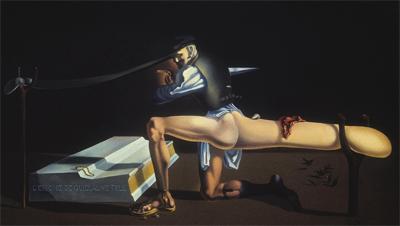 |
 |
||||
 |
|||||
 |
|||||
A crutch is generally thought of as assistance for the injured or disabled. It is generally a temporary object in one’s life, and it helps to hold up the entire body when one is unable to support oneself. Dali’s use of the crutch is similar in that he uses it for support, but it seems to be more for emotional support than the physical. In Dali’s work, the crutch supports the sexual or sensual parts of a body, particularly the phallic extensions of the bodies of his figures.
The clearest example of his use of the crutch is in the painting “The Enigma of William Tell.” This figure has two undeniably phallic appendages extending from both sides of his body at once. This man, both mysterious with his face and an exhibitionist with his naked body, has appendages so weighty that crutches must hold them up. This man is unable to hold his body parts up on his own and needs assistance to keep them upright.
This reflects Dali’s own sexual insecurities.
Like William Tell, Dali is unable to handle what he has on his own and requires assistance. Throughout his married life, Salvador Dali rejected the idea of sexual intercourse with his wife. Any sexual intimacy with Gala was unwanted because as he said throughout his life, he far preferred masturbation. He was unable to hold himself up when necessary, and like him, William Tell needs help staying up.
